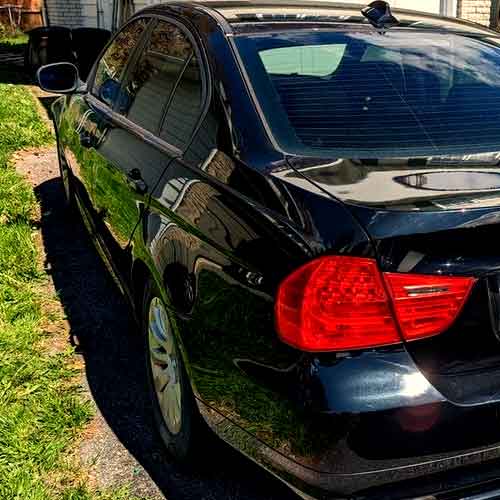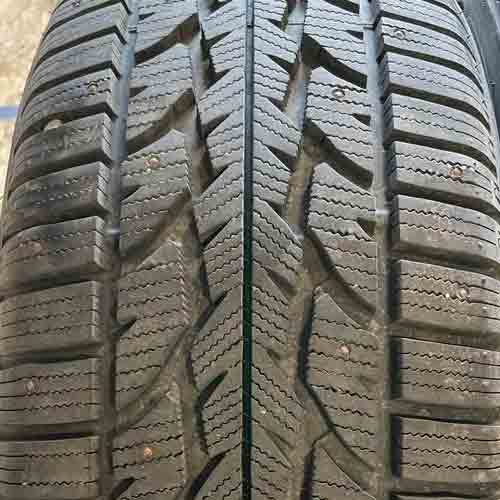Durable and sturdy, the WinterForce 2 is Firestone’s commitment to winter safety. Let’s start things off, with this tire’s main highlights.

Table of Contents
Main Highlights
The Firestone WinterForce 2 offers great performance in terms of:
- Dry Longitudinal Grip: Its continuous central rib ensures steady road contact, which leads to faster braking.
- Wet Traction: The tire’s aggressive siping strategy offers decent grip on wet terrains.
- Enhanced Winter Performance: Notably on ice, it has above-average braking and acceleration figures, and its snow traction benefits from a decent snow scooping abilities.
- Comfort Levels: The tire having softer overall rubber ensures a comfortable ride.
- Tread Durability: With an average tread depth of 12/32″, its lugs resist excessive flexing, adding to longevity.
However, the tire lacks in:
- Lateral Dry Grip: As the tire doesn’t offer good enough cornering (in terms of entering the turn).
- Comfort in Noise Levels: Tire is relatively still loud, due to its expansive shoulder voids.
- Fuel Economy: Though the tire features lugs with foundational supports, its overall fuel efficiency is just average.
Info on Sizes: The Firestone Winterforce 2 comes in 14 to 18″ rims, with all sizes having only “S” speed rating, and standard load ratings. Moreover, all sizes also have the same 12/32″ tread depth, and in terms of weight, they range from 15 pounds and go up to 35 lbs.
Tread Structure
The Firestone Winterforce 2 comes with a very aggressive directional pattern.

There are 5 ribs in total, where the shoulder lugs (on outer 2 ribs) are the most streamlined.
These shoulder blocks make rectangular shapes, and come with wave-like siping on them, just like seen everywhere else on the tread.
In the middle the 3 ribs, being pretty voided up, interconnect all outer circumferential grooves together.
Though the central most rib is continuous running. And it features slanted notches facing both sides, laterally.
Moreover, you also see snow vices here too.
The adjacent ribs also have similar features, though they also have stud holes, which are also seen on shoulder blocks too.
Dry Performance
Tire traction on dry surfaces is vital, including for winter tires, and here the efficacy of this traction relies on two primary factors: the amount of rubber that makes contact with the road and the tire’s steering responsiveness.
Moreover, grip can be further segmented into two categories: longitudinal (directional) grip and lateral traction. Let’s get deeper into each of these aspects.
Dry Longitudinal Grip
This grip pertains to a tire’s ability to maintain traction in a straight line, where it largely depends on how efficiently the central portion of the tire contacts the road.
But why is the tread’s middle area here so crucial?
It’s simple. As the tire rolls, the central part gets to face the most weight, resulting in maximum road contact. Given that this grip is directly related to direction, it’s no surprise that its effectiveness is measured by the tire’s braking performance.
Having said that, let’s take a look at our tire.
So the WinterForce 2 as an example shines brilliantly in this aspect, all thanks to its continuous central rib, which ensures steady road contact, translating to shorter braking distances and faster acceleration (as seen on tests).
As a result, when it comes to braking performance, the Firestone’s tire stands head and shoulders above other elite winter tire options.
Lateral Grip and Stability
Lateral stability of a tire is crucial during maneuvers, where the tire’s shoulders/sidewalls are pivotal in providing balance and ensuring agile handling, especially when navigating aggressive turns.
Interestingly, the Firestone’s tire, despite its noticeable voids, holds its ground here pretty well, as it matches the performance of elite winter tires, out there, such as the Michelin X Ice Snow (review this tire here).
But what’s the secret behind its impressive handling, even with its apparent shortcomings in directional grip?
The answer lies in its resilient rubber composition and the inclusion of a robust nylon cap ply in its internal structure. These elements bolster steering precision.
Although the WinterForce 2 approaches corners at a reduced speed (owing to its longer deceleration time), it compensates by delivering decent mid-corner feedback.
So you get pretty nice overall handling with this tire, overall.
Wet Performance
A tire’s wet traction is primarily dictated by its tread pattern and rubber formulation. This encompasses wet grip and hydroplaning resistance.
Wet Traction
Wet grip/traction, also hinges on the rubber’s contact with the road. But the thing is, water disrupts this bond, necessitating design features to counteract it.
These features mainly include two, grooves and sipes.
While grooves are responsible for displacing a majority of the water, sipes tackle the lingering moisture. They release air, producing a suction effect that extracts water and ensures consistent road contact.
Having said that, the Firestone WinterForce 2 showcases excellence in this realm with its aggressive siping strategy. It features a blend of dual wave-like and linear patterns, the latter focused on the central rib and the former on surrounding ones.
Thanks to these multi-angled sipes, the tire guarantees a multidirectional grip, anchoring it securely on wet terrains.
Though most of its traction is still attributed to its aquaplaning resistance (see in the next section).
Side Note: If you’re scouting for winter tires with superior traction, the Continental VikingContact 7 (review) stands out as a top contender. Just a tip.
Hydroplaning
Hydroplaning emerges when water accumulates between the tire’s surface and the road. And tires begin to float or hydroplane.
This is where the design of the tire’s grooves becomes crucial, serving to channel the water away and circumvent aquaplaning (another word for it).
Now, thanks to our tire’s pronounced voids, the Firestone WinterForce 2 excels in this area, delivering consistently high float speeds.
The tire’s distinct vine-shaped lugs, coupled with its directional tread pattern, efficiently dispel water and slush, yielding commendable hydroplaning resistance in both curved and straight paths, as validated by tests.
Tread Durability
The durability of tire tread is anchored in two interconnected elements: rolling resistance and tread depth.
The tread depth correlates directly with its lifespan, as a tire with more tread depth will typically take more time, reaching the regulatory minimum tread depth of 2/32″ (a standard in the U.S.).
Though, tread depth has an inverse relationship with rolling resistance, too, as deeper treads are more flexible, leading to increased heat production and heightened rolling resistance.
Now, this brings us to the Firestone WinterForce 2’s design.
As the tire is equipped with a good enough tread depth and lugs having foundations, it strikes a balance between durability and efficiency.
So even with an average tread depth of 12/32″, its lugs are designed to resist excessive flexing, ensuring consistent mileage.
So overall, you get above-average performance with this tire.
Comfort Levels
Tire comfort encompasses aspects such as noise reduction and vibration dampening, which are influenced by the tire’s construction, materials, tread pattern, and sidewall design.
Let’s start with noise.
Tread Noise
The primary source of noise is the collision of air with the walls of tire treads. In essence, tires with more significant tread gaps tend to be noisier.
Cutting down to the chase, the Firestone WinterForce 2 offers satisfactory noise levels, typical for winter tires. Its expansive shoulder voids, combined with multi-angled sipes, do contribute to a slightly pronounced hum.
However, the tire’s variable pitch tread design acts as its saving grace, efficiently reducing in-groove sound reverberations. It’s worth noting that among its peers, theWinterForce 2 is marginally louder, but the difference is minimal.
Bumps Absorption
Since tires come between the vehicle and road irregularities, they act as secondary suspension system. And how well they are depends on their ability to absorb road bumps, determining overall ride comfort.
Now in case of Firestone’s tire, its good enough efficiency in this regard rests on two pillars: its decent absorption capacity and overall stability.
The tire basically stands out due to its significant tread depth (of 12/32″), and softer overall rubber. Moreover as all its lugs have foundational supports, they also keep the stability in check.
(Tires with richer rubber depth contribute a lot to enhanced bump absorption, provided stability isn’t compromised).
Fuel Economy
The fuel efficiency of tires is intimately linked to their weight and traction attributes, both of which exert influence on rolling resistance.
Why is this the case?
Consider a tire with substantial weight and an aggressive tread pattern. It makes sense that such a tire is more prone to experiencing lug flexing during maneuvers due to the heightened pressure exerted on the lugs.
This flexing translates to energy diversion, where instead of rolling, energy gets wasted else where (mostly in to heat).
Having said that, the Firestone WinterForce 2 deals with this pretty nicely, the tire features lugs with foundational supports, so they aren’t allowed to flex a lot.
Though still, there’s a little room for improvement here, I should add.
I mean, the tire could have done a lot better here, if it had a little less overall tread depth.
So overall, tire’s fuel economy is just average.
Enhanced Winter Performance Overview
A tire’s winter proficiency primarily rests on its performance over two challenging terrains: ice and snow.
Let’s delve into each.
Ice Traction
Owing to the slippery nature of ice, a tire’s rubber composition and tread blueprint become pretty important.
For a tire to be considered adept on icy terrains, it should possess an array of pliable “biters” that remain effective even in sub-zero temperatures.
The Firestone WinterForce 2 impresses in this aspect. While there’s room for improvement in handling, it offers you with good enough (above average) braking and acceleration figures.
Moreover, with stud-ready lugs, its ice performance can be further augmented.
Snow Traction
Snow-covered roads, often soft and powdery in texture, present unique challenges for tires. Here, a tire must effectively penetrate the snow, creating a snow-to-snow contact, while also shedding excess snow to prevent buildup which can impede traction.
Why is this snow-to-snow contact crucial? It’s simple: snowflakes have an innate ability to cling to each other due to their intricate structures.
When trapped in the tire’s tread, they form a bond that’s far more gripping than mere rubber against snow.
In this context, the Firestone WinterForce 2 establishes a pretty decent contact patch, yielding consistently positive outcomes.
While there’s room to enhance its snow handling capabilities, the tire still delivers above-par performance in snow acceleration and braking.
To Conclude
So overall, the tire offers a lot of pros and cons.
In dry conditions, the Firestone WinterForce 2 shines with impressive braking and acceleration due to its central rib design, where it also maintains stability during maneuvers despite its voided tread.
For wet performance, the tire offers multidirectional grip and strong hydroplaning resistance overall.
In winter conditions, the Firestone shows good performance on ice, adequate snow handling, and impressive acceleration capabilities.
Moreover, it also offers a comfortable ride with acceptable noise levels, thanks to its significant tread depth and softer rubber.
And yes, since its keeps its rolling resistance low, its not too bad in terms of fuel economy and tread longevity.